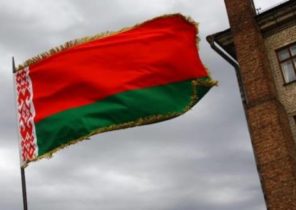After the October revolution of 1917 the Empire of Japan sent to Russia, the largest contingent, and during the Second world war has been the principle ally of the Axis, so its antagonism against Soviet Russia may seem a foregone conclusion. But it’s not.
At first, many in the Japanese government embraced Russian revolution positively, seeing in it a similarity with the Meiji restoration in Japan in 1868, which brought the country on the path of modernization.
Only when the radical winds blew in its colonies Korea and China, threatening its sovereignty, the Japanese Empire embarked on the path of anti-communism. Even many Japanese left, for example, the Communist party of Japan, broke with the Russians due to the fact that those focused on Korea and China.
The correspondent of the magazine “Jacobin” (“Jacobin”) Arvind Dilawar (Arvind Dilawar) talked with Tatiana Linhovoin, author of the book “the Revolution goes to the East: Imperial Japan, and Soviet communism”, the contradictory, at first glance, the views of Japanese leaders, military commanders, and even left the Russian revolution and Soviet Russia.
Arvind Dilawar: What was the relationship of Japan with Russia until the Russian revolution?
Tatiana Linhova: One of the main arguments of the book lies precisely in the fact that to understand the relationship of Japan to the Soviet communism and the Soviet Union in General, not considering Russian-Japanese relations in historical perspective, it is impossible. From the XVIII century, Japan regarded Russia as a Eurasian Empire with a vast Asian population and possessions, and a long history of relations with the Mongol and Chinese empires. Russia was to Japan a curious example: it was a European Empire, but its history, politics and economy largely depended on relations with the rest of Asia.
We can say that complex cultural and geographical situation of Russia has split the Japanese into two opposing camps: some believed the Russian state and society aggressive and expansionist, and therefore a direct threat to the Japanese nation; others felt that to work with the powerful Russian state is vital to the stability and prosperity of East Asia in General and Japan in particular. Until 1917 Russia and Japan have divided East Asia into “spheres of influence” and both did not want to put in the region of a third party — principally the United States. In my book I show how the two positions coexisted with each other since the days of the Russian revolution to the present day.
Many educated Japanese are strongly attracted by the giant of Russia’s critique of modern Western capitalism. The Japanese have cleverly noticed that the Russian anti-Westernism stems from the exceptional cultural, historical and geopolitical position of Russia, many Japanese it recalled the identity of their country towards the West and the rest of Asia. This longtime interest in Japan to Russian cultural and intellectual life, especially to Russian populism, socialism and other revolutionary movements — has created fertile ground for their ideas and ideologies, including socialist and Communist.
– Many Japanese have decided that the Russian revolution is something similar to the Meiji restoration of 1868. What were the Parallels?
In 1918, Japan celebrated the fiftieth anniversary of the Meiji Updates. The memory of it was still fresh, and was alive participants of the revolutionary events of the Meiji. The anniversary became the Japanese public the opportunity to reflect on how did the Meiji restoration on their promises — and what they all were.
The Japanese government and the General public has welcomed the February revolution in March 1917, which led to the abdication of Nicholas II from the throne. The February revolution was understood as a popular and democratic uprising of the people against the corrupt, autocratic government and its bureaucracy.
The most interesting question — what the Japanese audience thought about the Russian monarchy, given that Japan itself had its own Emperor. At first glance, to compare the Imperial house of Romanov with a Japanese dynasty would be quite natural.
However, after the February revolution, the reign of the Romanovs compared rather with the Tokugawa Shogunate, a military government of samurai, overthrew the revolutionaries of the Meiji era. So in those days the Japanese and the Romanovs and the Tokugawa was considered an outdated, feudal and autocratic. In General, both destined to disappear.
The subjective backwardness and stagnancy of the Romanov monarchy explains why the Japanese and the rest of the world reacted to the execution of Nicolas II and his family in the summer of 1918 with relative indifference. The Japanese government and media called the murder another result of the ongoing bloody revolution.
The October revolution initially made in Japan big noise. It was believed that the Bolsheviks had no broad political support, and they were considered a militant group, the power-hungry and doomed to an early failure. Their success is considered largely random, and in any case not a landmark event.
Like their Western colleagues, Japanese media condemned Lenin and the Bolsheviks for selfishness against the allies and lack of patriotism, but at the same time, hysterically predicted the imminent appearance of the German troops off the coast of Japan through their new Russian colony.
As the months passed, the Japanese learned about the Bolsheviks and their program more, and the opinion has changed. The October revolution was considered a revolution is a popular uprising of the lower class against the inept and ignorant authorities, ideological solution to the problems of Russia and the way to overcome its political and social underdevelopment.
Anyway, the Japanese interpretation of the Russian revolution was under the strong influence of the Meiji revolution and its values. In other words, the Japanese understand the revolution of the Meiji modernization — nationalist — designed to stop the advance of foreign powers.
The Russian revolution, in their opinion, put before themselves the same goal: to modernize and build a strong national state. It is noteworthy that when comparing the Meiji and the October revolution, the Communist ideology faded into the background.
Ultimately, Japan has played an active role in foreign intervention against the Russian revolution. If it was an opportunistic attempt to expand the Empire or staunch anti-communism?
— In short, the Russian policy of the Japanese Empire has evolved from a purely opportunistic seizure of land and resources in genuine concern because of the advent of communism in East Asia. I want to stress that Japan cared not communism in Russia itself, and its growing popularity in colonial Korea and China that threatened the Imperial authority of Japan.
When in 1917 the Russian Empire collapsed, the Japanese army and the Ministry of foreign Affairs urged to take advantage of the power vacuum in East Asia and to expand the colonial power of Japan — both formal and informal — to Siberia and the Russian far East.
When Woodrow Wilson (Woodrow Wilson) in the summer of 1918 took the decision to intervene, it allowed the Japanese General staff, the army and the Ministry of foreign Affairs to solve their own problem. In Tokyo reigned jubilant confidence that the Bolshevik regime will not survive the intervention, and that the plans of Japan in the region must prevail.
The most curious fact is that the Declaration of intervention of the Bolshevik regime was not determined as the enemy. It was assumed that Japanese troops sent to Russia to “save” her, though no one in the government so publicly and did not specify from whom or what. The Declaration promised the withdrawal of troops, when order is restored, and refused any kind of encroachment on the territorial sovereignty of Russia and its internal Affairs.
In reality, however, the Japanese government looked to new economic opportunities. Created a new special Commission for economic aid to Siberia, to “lay the Foundation for the economic activities of Japan as a counterweight to the concessions the United States and other countries.” To get into mining, oil, forestry, fishing industry and related infrastructure, was created by the Russo-Japanese trading company, the development Corporation Far East and Russo-Japanese Bank.
The work of the Commission was joined by all the major players of the time, including the company “Mitsui”, “Mitsubishi”, “Sumitomo”, “Kuhara” and “Furukawa”, which invested in Siberia large sums and worked closely with the army.
However, by 1920, the Japanese government seems to sincerely worried that the revolution might spill beyond Russia to China and Korea, creating a direct threat to the security of the Japanese Empire. To Bolshevik guerrilla forces in the Russian far East joined a few thousand radicalized Koreans and Chinese.
Recent Korean immigrants with knowledge of the Japanese language and served as interpreters, agents and informers, providing the Bolsheviks with invaluable assistance. Chinese and Korean anti-Japanese resistance fighters by the thousands joined the internationalist units of the red Army. The Japanese government on these developments and reports about the frequent skirmishes at the borders of the Empire cared so much.
However, the Siberian intervention was a strange war. Clear enemy was Bolshevism and communism was never mentioned. Although it was obvious the war against Russia and its people, and the violence was indiscriminate, the Japanese government relentlessly and cynically said about his friendship with the Russian people and argued that the alleged acts in his best interest.
Any mention of the Soviet state, whether positive or negative, from Japanese documents carefully edit out. The Japanese government has never stated its opposition or principled disagreement with the ideological attitudes of the new Soviet state.
Different factions of the Japanese state reacted differently in Soviet Russia, depending on whether they consider Soviet Russia and the Communist international one or different entities. Why Soviet Russia and the Comintern came to Japan different?
— For Soviet foreign policy was responsible for two organizations: the Ministry of foreign Affairs and the Comintern. But their aim was different. A bloody civil war in Russia was aggravated by foreign intervention, when the different parts of Russian territory was occupied over ten countries. It was the first modern multinational intervention in foreign territory, and the survival of the new Bolshevik regime was called into question.
To preserve the territory and to ensure its own survival, the Soviet government was elected with the Empire of Japan policy of appeasement and cooperation. The Soviet foreign Minister publicly stated that will not encourage any Communist activities in the territory of the Japanese Empire, and publicly agreed with the aggressive intervention of Japan in the politics and economy of China.
The Comintern, on the other hand, was the organization of international and global — the devotees of the foreign members of the Communists until the late 1920-ies was retained some degree of independence from the Soviet government. His main goal was world socialist revolution. Part of the work of the Comintern was to create the foreign Communist parties and bringing to power of supporters of socialism.
But when their hopes for a socialist revolution in Europe failed to materialize, the Communist international appealed to the Japanese Empire as the most industrialized country in Asia — considering that Japanese workers are ripe for the proletarian revolution. The Communist party of Japan was established as a cell of the Comintern in 1922, and immediately began to conduct various Pro-Communist activities.
In fact, the Soviet Ministry of foreign Affairs and the Comintern did in Japan work the opposite. The first were normal diplomacy and signed treaties with the capitalist countries, including Japan. The latter destabilized the Empire of Japan, especially in the colonial territories of Korea and northeast China, while Stalin did not dissolve it completely in 1943.
– To what extent is the Japanese view of the left in Soviet Russia shaped the internationalism, especially Korean and Chinese independence movements?
— Japan annexed Korea — against the background of ideological attitudes in its cultural and political backwardness. Ironically, the Japanese left ended up in the same nationalist trap. Although it is Korean radicals were a vital link between Japanese leftists and Bolsheviks, and the Korean resistance movement — the Communists and not only the most consistent, resolute and implacable, the sympathy of the Japanese left in General was not on their side.
Japanese Communists were convinced that the colonial Korea and China are at a different stage of development compared to the more developed, industrial Japan. In addition, the Japanese Communists believed the Korean and Chinese independence movements are too nationalistic, that their struggle for independence overshadows the main idea of Marxism and the proletarian international.
When the Soviet theorists, such as Nikolai Bukharin, suggested that the Japanese Communists first will help the Chinese revolution, and the destruction of the Japanese Empire and the authoritarian state will start with colonies, the Japanese left didn’t agree. In their opinion, in the whole of Asia, only the Japanese industrial proletariat has reached advanced level of the proletarian and internationalist class consciousness, and he alone is able to lead and represent other colonial workers.
Japanese liberals in the 1920-ies supported the state’s struggle with the Communists, anarchists and other socialists. As it has paved the way for Japanese fascism in the 1930s?
— Japanese pre-war liberalism was characterized by commitment to the state of belief that the Imperial state is responsible for the welfare of his subjects. In other words, the liberals were in favor of representative government under the auspices of the monarchy, the dominance of populist parties, the reduction of bureaucracy and responsibility of the military. Japanese liberals believed that democratic politics ultimately serves national unity and social harmony.
It is not surprising that Japanese liberals together with conservatives were afraid of Soviet communism — especially its calls for class struggle, seeing it as the main ideological threat to the national political structure of Japan. At the same time, the liberals pursued their own goals. Leading their own struggle for the democratization of Japanese politics, Japanese liberals to escalate the “red menace” to convince the government and the public that only universal suffrage will stop the “Bolshevization” of the Japanese nation.
Without going into a long-running dispute about whether it is legitimate to speak of “fascism” in Japan and East Asia, I can confidently say that in time of war, no outside fascist or radical right-wing party or group to capture political power in Japan could not. Modern Japanese state and its apparatus was too strong, and any stranger could not challenge them.
This is a key difference between the Imperial Japan, on the one hand, and Nazi Germany and fascist Italy on the other. In pre-war Japan continued repression of the left opposition by the state with the support of the liberals and the conservatives — has led to a “fascist” society, which ceteris paribus was deeply conservative and neotraditionalists.
– What do you think, is it worth to remember about this period of Russian-Japanese relations today, especially the current left?
In Western science was often considered that the political and military elite of Japan in the interwar period was a natural-Communists. Projecting Imperial Japan own beliefs about communism and anti-communism and studying history from the perspective of the cold war, the Western reader often misses the point that the Soviet-Japanese relations to develop according to its own logic.
The geographical proximity, long-term relationship before the Russian revolution, mutual economic and political interests in China, concern about US intervention, the General recognition that the political and the public is above the economic as well as mutual cultural and intellectual appeal are the key elements of Soviet-Japanese relations.
I guess my main claim to the left in the pre-war East Asia is that they are unable to present a United regional front. The national left-wing movement were focused on their own countries. Acutely aware that alone the Imperial state they do not change, and only in Union and concerted efforts with the Korean, Chinese, Taiwanese, Vietnamese, Mongolian, Indonesian and finally, the Russian Communists, anarchists and socialist — left-wing Japanese still failed to become true internationalists. But I don’t want to make value judgments. I’m not sure that such a thing was possible.
Linhova Tatiana — associate Professor of history at new York University and author of “the Revolution goes to the East: Imperial Japan, and Soviet communism”.
Arvind Dilawar is a writer and editor whose articles have appeared in Newsweek, The Guardian, Al Jazeera and other publications.







